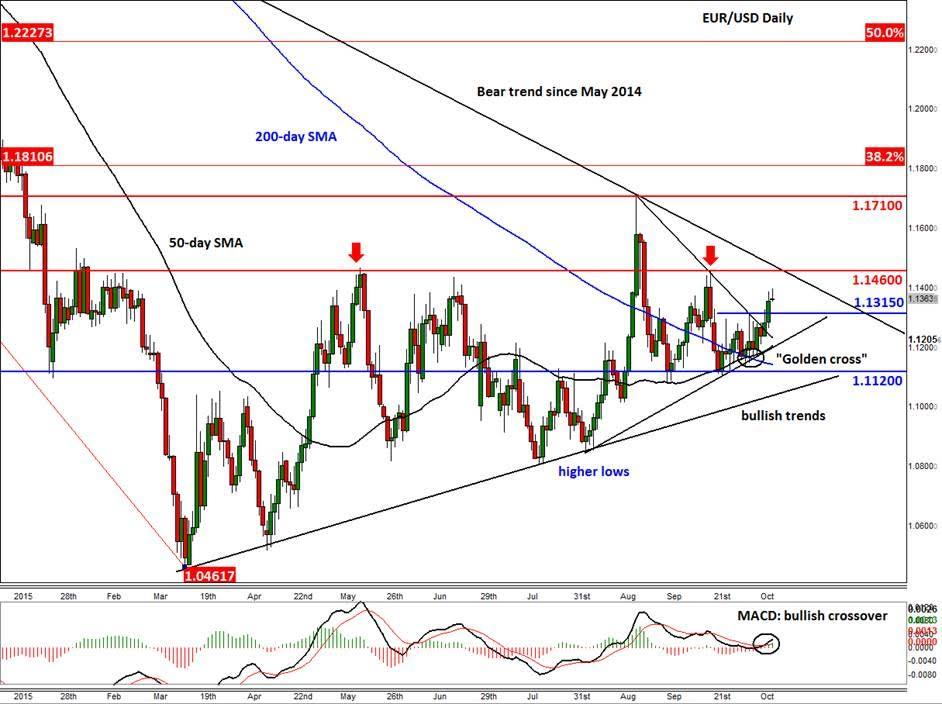![]()
Understandably, it has been a quiet session in the FX markets so far today due to the holidays in Japan, the US and Canada, and the lack of any major European economic data. Last week was a bad one for Eurozone data, most notably Germany, so this week’s numbers will probably garner more attention than usual. Amid the lack of any noticeable economic growth so far, there have been suggestions that the European Central Bank may have to bolster the size and duration of its bond purchasing programme for it to achieve the 2% inflation target. At the moment, inflation in the single currency bloc is just 0.1% and is thus hovering just above the deflationary levels. If the recent run of soft patch data continues then calls for a more beefed up QE stimulus package would grow and this would likely weigh on the euro. So far however officials from the ECB have shown little or no enthusiasm for increasing easing measures. The EUR/USD currency has of course been helped by a slightly depreciating US dollar after the recent decision by the Federal Reserve not to increase interest rates. The subsequent disappointing US monthly jobs report has further reduced the probabilities of a 2015 rate increase, even if the Fed officials – for example Vice Chairman Stanley Fischer – continue to suggest a lift off this year is still on the cards. So unless things change dramatically soon, the USD could lose further ground which could underpin the EUR/USD slightly further from these levels. Ultimately however the current fundamental backdrop argues for lower levels on the EUR/USD from a slightly longer term point of view.
As expectations about the Eurozone and US interest rate differentials continually change, the EUR/USD has been quietly making a comeback after it posted a low at just above 1.0460 in March. Ever since then, the world’s most heavily-traded FX pair has been making a series of higher lows and a few higher highs. A bullish trend line has thus been established, which has now been defended more than three times. The 50-day moving average has also been trending higher and it has now moved above the 200 SMA. This so-called “Golden Crossover” is a further bullish technical sign, which is further confirmed by the corresponding crossover of the momentum indicator MACD above the signal line (see the sub chart). What’s more, a short-term bear trend has also been taken out, as has resistance around 1.1315.
The short-term path of least resistance therefore is to the upside as we head towards another important resistance at 1.1460. This level had acted a strong resistance in the past and this time it is also where the bearish trend line that has been in place since May 2014 comes into play. Therefore a potential breakout above here could lead to further follow-up technical buying, possibly towards the August high of around 1.1710 at the very least. Thereafter is the 38.2% Fibonacci retracement level of the downswing from the May 2014 peak, at 1.1810, followed by the psychologically-important level of 1.1200.
On the downside, the old broken resistance levels such as 1.1315 could now turn into support. Below 1.1315 is the first of the two bearish trend lines, which incidentally comes in around the 50-day SMA at 1.1205. Then it is the key horizontal support at 1.1120, which needs to be defended otherwise the long-term bearish trend could resume.
Trading leveraged products such as FX, CFDs and Spread Bets carry a high level of risk which means you could lose your capital and is therefore not suitable for all investors. All of this website’s contents and information provided by Fawad Razaqzada elsewhere, such as on telegram and other social channels, including news, opinions, market analyses, trade ideas, trade signals or other information are solely provided as general market commentary and do not constitute a recommendation or investment advice. Please ensure you fully understand the risks involved by reading our disclaimer, terms and policies.
Recommended Content
Editors’ Picks
AUD/USD rises to two-day high ahead of Aussie CPI

The Aussie Dollar recorded back-to-back positive days against the US Dollar and climbed more than 0.59% on Tuesday, as the US April S&P PMIs were weaker than expected. That spurred speculations that the Federal Reserve could put rate cuts back on the table. The AUD/USD trades at 0.6488 as Wednesday’s Asian session begins.
EUR/USD now refocuses on the 200-day SMA

EUR/USD extended its positive momentum and rose above the 1.0700 yardstick, driven by the intense PMI-led retracement in the US Dollar as well as a prevailing risk-friendly environment in the FX universe.
Gold price cautious despite weaker US Dollar and falling US yields

Gold retreats modestly after failing to sustain gains despite fall in US Treasury yields, weaker US Dollar. XAU/USD struggles to capitalize following release of weaker-than-expected S&P Global PMIs, fueling speculation about potential Fed rate cuts.
Ethereum continues hinting at rally following reduced long liquidations

Ethereum has continued showing signs of a potential rally on Tuesday as most coins in the crypto market are also posting gains. This comes amid speculation of a potential decline following FTX ETH sales and normalizing ETH risk reversals.
Australia CPI Preview: Inflation set to remain above target as hopes of early interest-rate cuts fade

An Australian inflation update takes the spotlight this week ahead of critical United States macroeconomic data. The Australian Bureau of Statistics will release two different inflation gauges on Wednesday.
